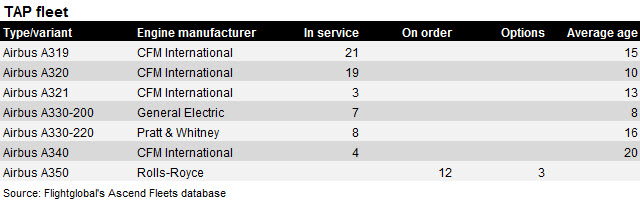TAP Portugal’s planned introduction of the Airbus A350 in 2017 will have a major impact on the future direction of the airline’s MRO division.
Most of the maintenance for TAP’s in-service fleet is conducted in-house. But competition for aftermarket business is intensifying on new-generation aircraft, and TAP Maintenance & Engineering will be able to support only certain components of the A350.
Today, the Portuguese flag carrier’s engine overhaul shop in Lisbon is servicing the CFM International CFM56 powerplants for its A320-family and A340 aircraft. That fleet comprises 43 narrowbodies and four A340-300s, Flightglobal’s Ascend Fleets database shows. The engines powering TAP’s 15 A330-200s – split between General Electric CF6- and Pratt &Whitney PW4000-powered aircraft – are meanwhile supported by external MRO providers.

Independent in-house maintenance of the Rolls-Royce Trent XWB engines is not an option due to the lack of work volume for the 12 on-order aircraft, says TAP’s executive vice-president maintenance and engineering Mario Lobato de Faria. “The level of investment we [would] have to do, namely on the test cell and equipment and tooling – I think for our fleet it doesn’t justify the investment,” he says.
TAP has not yet determined how the powerplants for the future long-haul fleet will be serviced, and is discussing maintenance options with Rolls-Royce and other A350 customer airlines. But with the UK manufacturer aiming to capture the aftermarket business for the Trent XWB, Lobato de Faria says it is uncertain whether large A350 operators planning to maintain their engines in-house will be able to serve third-party customers. “It is clear to us that the market share is going to be very tight,” he says. “I think that aside from Rolls-Royce, very few engine shops at airlines are going to do the service. And perhaps they are just going to do the service for their own fleet.”
There has been a decline in TAP’s third-party engine maintenance business. Aside from the CFM56-5 series engines powering its own fleet, the MRO provider supports -3 and -7B variants for Boeing 737 operators as well as legacy CF6 engines, and the CFM56 support business – the shop’s mainstay – has shrunk as a result of MRO overcapacity, longer-than-expected on-wing times, and legacy CFM56-3 operators using second-hand engines rather than overhauling existing equipment.
Searching for customers in previously untapped markets will not be enough to recoup the lost business, admits Lobato de Faria. Instead, TAP will need to broaden its support offering to include services such as engineering, spare-parts supply and equipment financing. But more significantly, the group aims to co-operate with other MRO providers and specialise in certain equipment repairs. Rather than serving whole engines, TAP M&E may need to become a specialist for certain repairs it can supply to partners, and thus focus capabilities and investments on individual tasks, says Lobato de Faria. The group is discussing options for co-operation both with manufacturers and other airlines, he says.
The future of the Lisbon engine shop will depend on support of the airline’s short-haul fleet as its base workload. TAP has not yet ordered a successor to its A320-family fleet, which has an average age of 13 years. The aim is to continue maintaining the next engine generation, which would either be the Leap or PW1000G geared turbofan, says Lobato de Faria. But he adds that “if we don’t support our own narrowbody fleet… we will have in the future more difficulties in [sustaining] the engine shop”.
Also in the components maintenance arena, TAP will depend on partnerships with other MRO providers and manufacturers to support the A350. “We need to understand up to which level we can actually support those components. Some of the component OEMs… will fight very hard to keep the support for their own [equipment]. And all this is yet not very clear for us,” says Lobato de Faria.
What components will be available for repair at the airline’s workshops has yet to be determined. When this becomes clearer, he says, TAP needs to assess whether or not it is economical to complete the work in-house, and evaluate “any offsets in terms of business change” if support tasks were to be outsourced.
“The A350 can help us out in terms of better defining our… future industrial strategy,” says Lobato de Faria. As with engines, TAP may specialise in certain repairs and components. This will depend on what equipment will be available for repair, how existing capabilities can be utilised, and what investments will be necessary to support the A350 components. The MRO provider will also need to decide what kind of customers it wants to attract and what partnerships will be best-suited to target that market. The next two years will thus be “very important” in determining TAP M&E’s future industrial strategy and commercial opportunities, says Lobato de Faria.
All will ultimately hinge on the future ownership of the group. Portugal’s government has been trying to privatise TAP for some time. Brazil’s Synergy Group – which owns two-thirds of Colombian carrier Avianca – tried to buy a stake in TAP, but the deal was rejected by the Portuguese government in late 2012. Nevertheless, the privatisation plans could be revived, TAP chief executive Fernando Pinto hinted in April.
“New shareholders may have different strategies or even bring some muscle into the business,” says Lobato de Faria. But since TAP’s future ownership situation remains uncertain, he says the group division must adapt its maintenance division “with all our efforts” to the changing MRO industry through co-operation with other aftermarket players: “At this stage, it is worse for us to do nothing and wait for that moment [when TAP is sold]. So we should continue to follow this [partnership] path irrespective of what the future can bring in terms of privatisation.”
Source: Cirium Dashboard























